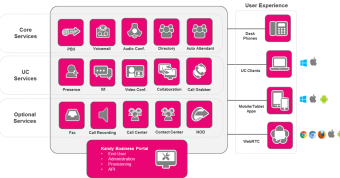Reshaping the CX: How Service Providers are Out-Performing OTT Challengers
Customer Experience (CX) matters, and in our hyperconnected world, where conversations are continual and contextual, Communications Service Providers (CSPs) are getting creative. They are bringing not just voice services but embedded communications to enterprises that are differentiating their brands by delivering great CX.
Communications Platform as a Service (CPaaS) solutions are scaling up from several of the world’s largest CSPs, including AT&T and KPN, leveraging their inherent advantages to successfully compete against non-traditional players who changed the game with over-the-top (OTT) services for consumers over a decade ago, and now are impacting enterprise revenues.
Enabling the Contextual Experience

Elaborating on the huge opportunity for CSPs in CPaaS, Raul Castañon-Martinez from 451 Research explains, “We see CPaaS as one of the underlying technologies for enabling the contextual experience for customers and employees and anticipate that this market will only continue to grow, given the increased focus on the user experience.”
By providing marketplace access and easy-to-integrate APIs, CSPs can deliver voice, video and chat services with carrier-grade, no-code to low-code, real-time communications (RTC) capabilities. These capabilities are changing the way customers interact with businesses through web, social, mobile, kiosk and other contextual experiences that don’t require a “phone number” to be dialed.
What is attractive, in addition to being able to support creative and efficient CX interactions, is the speed at which these CPaaS services can be rolled out. There is no need for the physical lines and circuits associated with traditional telecom services or the significant capital expenditures associated with on-premise deployments.
As Michael Brandenburg, an Analyst at Frost & Sullivan puts it, “CPaaS and embedded communications are disrupting legacy communications and collaboration technologies by allowing service providers to open up their communications services to the enterprise and developer markets. By breaking voice, video and messaging services down into very simple but easily consumable and deliverable elements, service providers are able to quickly deliver their enterprise customers revenue-generating turnkey real-time communications applications.”
Service providers can simply deliver these real-time communications capabilities from an API store or marketplace where they are easily accessible to enterprise and developer customers.
Real-Time Communications Offerings
CPaaS offerings are deepening the relationships between CSPs and their business customers, as they can bundle services to create new feature-rich real-time communication offerings that make conversations immediate, affordable and efficient for both the consumer and the business. The impact on contact centers, for example, can be dramatic in that call handling times are shortened (and in some cases, those inbound calls can be eliminated through self-service).
Service providers are in a great position to reshape the enterprise CX. By giving enterprises the ability to protect current Unified Communications as a Service (UCaaS) investments and customers while API-enabling their offerings, it will go a long way in helping enterprises build a seamless bridge to the digital world. These programmable communications integrate directly into a business’ existing applications and services, including cloud contact center and unified communications, creating an elevated, contextual customer experience.
Courtney Munroe, Analyst at IDC, explains, “CPaaS platforms facilitate agility and innovation by offering simplified and rapid on-ramp capabilities to implement and enhance enterprise applications with new functionalities. They are also helping companies rapidly implement embedded communications into their existing business processes with minimal disruption and reduced complexity compared to legacy software platforms – all while providing them with the ability to expand their market reach by providing low-cost communication transactions at scale.”
As the boundaries between these conversational communications services continue to blur and evolve, leveraging APIs to differentiate and create new ways to interact, via voice, messaging and video, is dramatically changing the landscape and has the potential to deliver amazing customer experiences.
When we add in big data analytics, AI and machine learning capabilities, and intersect the Internet of Things (IoT) with human communications, the possibilities for enterprises to blend great experiences into their products and services are limitless.





